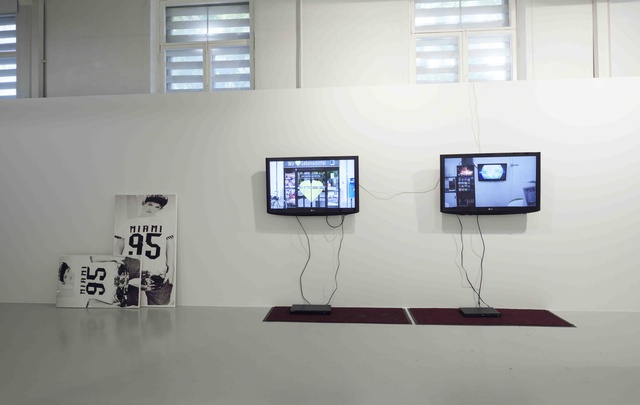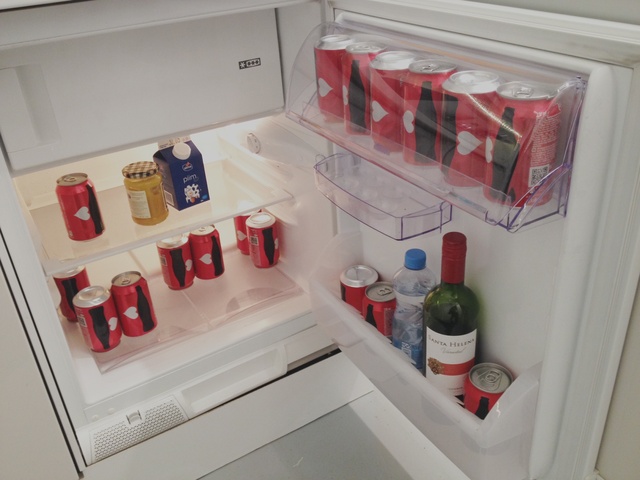Hearts of control Dan Mitchell on Gili Tal at Temnikova & Kasela, Tallinn
This summer, Gili Tal staged a solo show at Temnikova & Kasela gallery in Tallinn. A relatively small city but the largest in Estonia, Tallinn is not untouched by the violently boring comforts of capital and the pretense of corporate familiarity that neoliberalism has brought to many major economic centers.
These conditions are not lost on Tal – nor on Dan Mitchell who, in town for Tal’s opening, took a room at Tallinn’s Swissôtel and later penned the following piece. As Mitchell (a London-based artist himself) notes: from luxury hotel to art gallery, it’s only a short walk.
A stay in a modern metropolitan luxury hotel is the zenith of contemporary, sensational non living. On the stages of its private and secure skeleton, the guests/actors come to play out euphoric rituals. Nearly all buildings are machines that are designed to extract the maximum capital from the land. The modern hotel represents the pinnacle of this transformation of earth into gold. The Terminator franchise posited a future in which AI-enabled killer robots police capitalism. The machines that now radiate this power are these static, curtain-walled buildings, common to many as a prime manifestation of hermetic exclusion and control. This architectural mode spreads like an enormous and untreatable virus – it was first transmitted to airports and office developments, and is now the standard model for domestic regenerative alienation. The lifestyle coordinates promoted in the developer’s brochures of these neo-domes are directly transferred from the marketing materials used to advertise modern hotel living.
 Swissôtel Tallinn
Swissôtel Tallinn
The Swissôtel in Tallinn [2] has all you need in the look and feel of one of these structures; in five-star luxury, it hosted Barack Obama during his state visit there last year. The 30 floors of glass veil shield the Supreme Being of lifestyle suspended within. I felt the building’s force field open up and welcome me as my taxi pulled into the forecourt; I had a few hours to kill before the opening of “Agonisers” by Gili Tal and planned to lose myself fully in its corporate immoderation – which would be mine for €160 a night.
From the lobby to the elevator, from one corridor to the next, I am fully seduced – and monitored. This extends to my room, the bar, the sauna, the steam spa, the pool, the gym. All exchanges with the hotel’s lifestyle betrayal managers are designed to ensure my worth is continually validated, and any desire to corrupt or antagonize is smothered. As long as I present my keycard, all is smooth, boring, and utopian. I am immediately addicted to this experience. Venturing outside in search of lunch, I am compelled to return to the ease and comfort of my new domicile as soon as possible. I pretend that it’s ironically cool, or just the right amount of OK to be OK, but deep down I need the enormous bed, the deep-pile dressing gown, and the knowingly designed interior that signals my newly elevated status. I take a rainforest shower and parade my nakedness at 300 feet for all to see through the transparent wall. From the street I’m merely an anonymous faint pink blob in this tinted glass tower. Within this ideal cell of communal luxury I take a moment to read the pillow menu by naturalized halogen light; I am complete.
Being inside the inside radiates into my consciousness. I want to commune with my fellow prisoner-guests: on this occasion, a select couple of hundred delegates attending the NATO/NSA-sponsored conference on Cyber Conflict. They are here to channel Anti Access and Area Denial Operations and to discuss how to exploit Cyber Power to achieve strategic, economic, and political goals. My interactions, however, are limited to muted comments on the decor or the view of the Gulf of Finland from the breakfast lounge; they are met with faint nods of vague approval.
Later, I peer down from the 27th floor onto the gallery I’m here to visit: Temnikova & Kasela, which is housed in the old boiler room of a grey Stalinist era residential building. Its surface is decorated with sheaths of wheat cast in concrete; its spire is topped with a revolutionary star. Before venturing down to see Gili Tal’s latest show, I decide that a quick third sauna and steam of the day would help. Refreshed and semi-tranquilised, I start the two-minute journey to the gallery. But the newly unreal, old world of grit and uncontrolled atmosphere overwhelms. I detour through the neighbouring Stockmann’s department store and buy a Diet Coke. 60 seconds later I’m inside the gallery, an idiosyncratic space; a long L shape with an entrance wall dominated by remains of its preexisting black mass of Soviet-era industrial plumbing.
The poster/invite to the show is a photograph of the artist’s laptop sprouting two LED-illuminating fans (powered via a USB connection) that look desperate for attention. Flanked by these manic, hypnotic cyclopean heads, the laptop shows an image of store shelving filled with six-packs of Coca Cola and a Wall’s ice cream fridge nestled in the corner.
In the main space, twin monitors screen “Agoniser 1 (Love and War)” and “Agoniser 2 (But the World Keeps on Turning)” (all works 2015); on the floor beneath lays “Americana,” a corresponding pair of functional non-decorative doormats. Each lasting one minute, the loops act as chronographs showing, respectively, the automatic doors of a supermarket in Berlin and the customer waiting area of a commercial printer in London. Unremarkable time slips by unceasingly. The robotic doors open; the robotic doors close; the Klix coffee machine waits forever for a parched customer.
The show includes two painting diptychs: “Flâneur ’95,” placed next to the videos, and “Flâneur ’69,” at the other at the end of the gallery in the foot of the L. In both pairs, the canvases are hung at right angles to each other (so that one is rotated 180 degrees). All four paintings portray the same facsimile of a young androgynous man in American-inspired sportswear – an outsize T-shirt emblazoned with “Miami 95” and a baseball cap that reads “Los Angeles.” Clandestinely housed in the gallery’s kitchenette, there is also a Coke-filled refrigerator sculpture, “Benevolence/Malevolence,” with cans positioned alternately right way up and upside down, amid the fridge’s usual contents of red wine, milk, and mustard.
 Gili Tal, “Gili Tal, “Agonisers,” Temnikova & Kasela, Tallinn, 2015, installation view
Gili Tal, “Gili Tal, “Agonisers,” Temnikova & Kasela, Tallinn, 2015, installation view
At first, this elegant and minimal show seems to describe a knowing sense of indifferent peace with its observations of everyday forms of living and capital. But this initial impression implodes under the weight of the themes engaged: the violently centralizing forces of the agents of control and the distracting effects of the virtual elsewhere. Political and economic theory quotes from Lefebvre and Marx in the press release help freeze-frame our shape-shifting enemies. Further connections start to emerge: the flipping of the Coke cans in “Benevolence/Malevolence,” for example, is echoed in the arrangements of “Flâneur ’95” and “Flâneur ’69.” This number displacement combined with centennial celebration Coke cans bring up dates as markers of men’s modernism; Duchamp, Picasso, Bacon, and Warhol come to mind. These artists viewed their experiences of the world either as reflected within their own psychology – usually dark and full of menace and pain – or in the glossy outer surface of mass production.
To look closer at Tal’s work reveals the same dark intensity as found in the output of her male predecessors. But whereas they gained fame by the opening up of their nervous systems or offering of grand displays of banality, Tal deftly shows these two modes in combination, opting for a shared understanding of neoliberal regeneration and its requirements of slavish observation, constant stream of mirroring commentary, and the co-opted reproduction of the self. She allows and encourages feeling to guide your mind, for us to see through her eyes, to see the reflections of city living as she does. The heart motif is repeated throughout: in the poster, on the Coke cans, and on the automatic doors in “Agoniser 1.” It’s a representation of health, care, and love that marketing professionals use in an attempt to connect with us at some level of significance. Of course this is pretence, the only heart beating here is our own, pumping our blood into the greedy mouth of the ever-thirsty vampire of capitalism.
 Gili Tal, “Benevolence / Malevolence,” 2015, installation view
Gili Tal, “Benevolence / Malevolence,” 2015, installation view
To say that this show points to an antidote for lifestyle supremacy would be to claim that this was Tal’s objective; it is not. And that such a relief is possible, it is not. In our daily reactive state, what it means to be modern is to have to deal with the exchange of one poison for another – this is the only rational remedy available for the constant conflict-ridden scenarios of non-living. Art under the conditions of the brutal restoration of neo-feudalism needs to have a form of integrity attuned to the struggle of building a life for the living. Tal’s show is simple yet difficult, full of the qualities needed to know that happiness is here now, and that if we are vigilant that happiness can be ours.
Back in London, I’m reading the promotional literature for the delegates of the 2016 International Conference on Cyber Conflict:
“In today’s increasingly complex cyberspace we see a variety of actors struggling to gain or maintain their position. The ubiquitous use of information and communication technologies has had a profound influence on how these actors pursue their goals and interests.” [3]_
I think about the show: the androgynous figure reproduced in the flâneur works, the spinning fans in the poster, the mirrored doors relentlessly opening and closing. There is the constant desire to be seen, to be looked at while looking back – the lookers looking at you looking at them looking … the command of this modern attribute has to be well rehearsed by the time the prepubescent phase has begun. The adolescent boy/girl in Tal’s image seems to have the confident regard of a seasoned pro that has this stance down to a fine art. But this raises questions: How does it feel to have succeeded in becoming a poster child of the grim cult of youth? How will life advance now that so much has been formed so young? Will s/he be permanently fixed in this act of endless self-repeating reproduction? What is it to be trapped forever in the hysteria of the instant has-been? How will the spectacle of living be maintained in a totalitarian boredom of access all areas? What is a life lived in an endless precession of staged and recurring acts? What will become of our becoming? Will we keep going on and on until finally being found dead, killed by tedium, in the lobby of a luxury hotel?
Gili Tal, “Agonisers,” Temnikova & Kasela, Tallinn, Estonia, May 27–June 20, 2015.
Notes
| [1] | Gili Tal, “Agoniser 2 (But the World Keeps on Turning),” 2015, film still |
| [2] | http://www.swissotel.com/hotels/tallinn/. |
| [23] | https://ccdcoe.org/cycon/home.html. |

